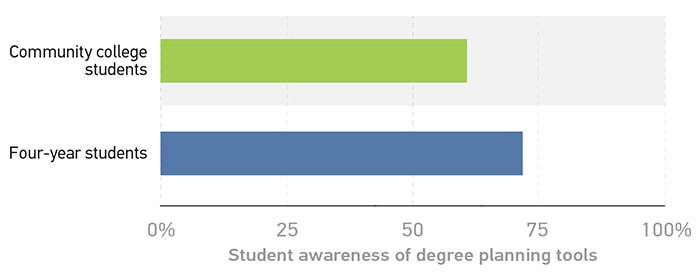Student Success Tools
Both community college respondents and their four-year counterparts shared similar views about the usefulness of the online student success tools provided by their institution, with only slight differences observed. Overall, both groups told us that tools that aid them in the business of being students (e.g., degree planning/mapping, degree audit, and self-service systems for registration, tracking credits, transfers, and dual enrollments) were more useful than those that help them with their academic success (such as early-alert systems and tools that suggest how to improve in a course). However, significantly fewer two-year and AA students reported that degree planning and mapping tools (those that identify courses needed to complete degrees) were provided by their school. Only 61% of community college students said they knew that online degree planning tools were available to them, compared with 72% of those at four-year institutions (figure 4). This suggests that more than a third of two-year and AA respondents either aren't aware of or don't have access to such resources. And these are tools that could have a positive impact on their academic success. Among the community college students who said degree planning/mapping tools were provided, nearly two-thirds (65%) said they were very or extremely useful.

Online success tools can help students identify courses needed to complete their programs, save students and advisors time, reduce errors, and increase graduation and credential completion rates.1 Integrated Planning and Advising for Student Success (iPASS) initiatives also have the potential to improve success rates, especially for students who may be unprepared for college-level work.2 Similar to our findings in the 2018 student study, online success tools are valued by students from underrepresented groups who have access to such tools. Significantly more minority than white students at community colleges rated many success tools as very/extremely useful, including early-alert systems, tools that offer guidance about courses to take in the future, and tools that suggest how to improve course performance. For community colleges that are using these kinds of tools, this is good news, especially when we consider that more minority students attend two-year and AA degree-granting colleges than four-year institutions. IT professionals at community colleges are also recognizing the importance of these tools. AA institutions rated "technologies for planning and mapping student educational plans" and "integrated student success planning and advising systems" No. 2 and No. 4, respectively, in the Top 10 strategic technologies for 2019. Results from this study indicate that AA colleges are devoting attention to planning and expanding these technologies on their campuses. Online success tools can be part of a tech arsenal that works to combat the racial and ethnic disparities in existing credential completion rates.3 But to maximize these benefits, students must be aware of online success tools and know how to use them, so promotion of these resources through faculty and student training is critical.
Notes
-
Antonia Ceballos and Kathy James, "Redesigning Austin Community College: Transformation through Integrated Technology," EDUCAUSE Review 52, no. 6 (November/December 2017); Hoori Santikian Kalamkarian, Melissa Boynton, and Andrea G. Lopez, "Redesigning Advising with the Help of Technology: Early Experiences of Three Institutions," Community College Research Center, Teachers College, Columbia University, July 2018.
↩︎ -
"7 Things You Should Know about IPAS," EDUCAUSE Learning Initiative.
↩︎ -
D. Shapiro, A. Dundar, F. Huie, P. Wakhungu, X. Yuan, A. Nathan, and Y. A. Hwang, Completing College: A National View of Student Attainment Rates by Race and Ethnicity – Fall 2010 Cohort (Signature Report No. 12b) (Herndon, VA: National Student Clearinghouse Research Center, April 2017).
↩︎